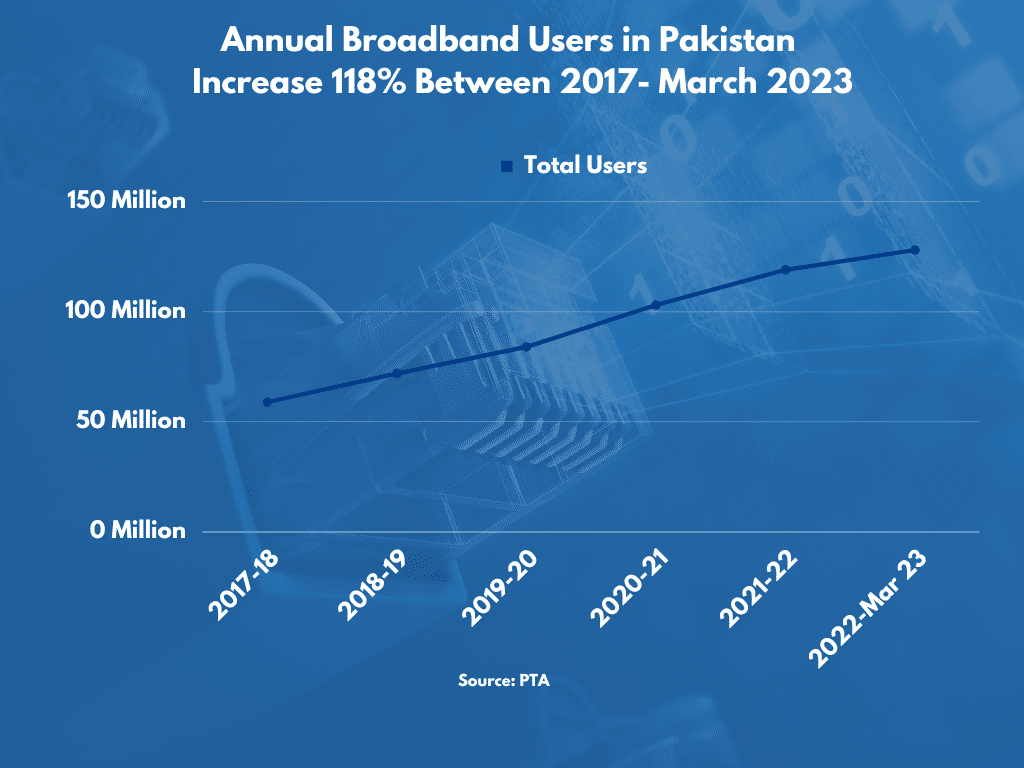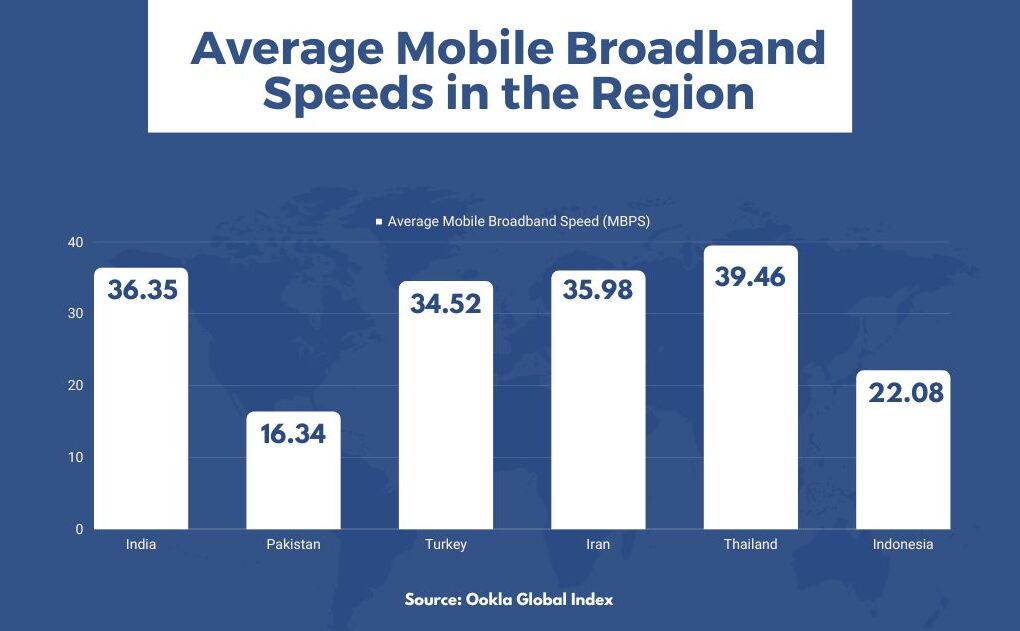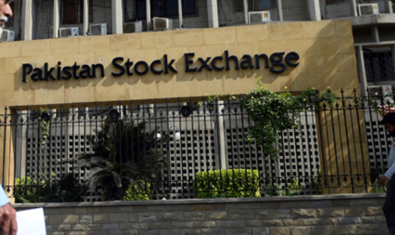Seamless broadband connectivity plays a crucial role in linking businesses and ensuring social development across the board.
Pakistan has witnessed significant progress in internet connectivity in recent years since the introduction of 3G and 4G in 2014. Pakistan’s broadband connectivity has witnessed a 118 percent increase in terms of users since 2017.
As of March 2023, Pakistan has 128 million broadband users with 54.13 percent broadband penetration. While the figure is on par with regional competitors, the industry is facing significant challenges in high-speed and reliable connectivity across the country.

There is still a huge difference in the state of digital connectivity between rural and urban populations. This digital divide is hampering economic inclusion and social development in rural communities.
According to a study conducted by Asian Development Bank, a 10 percent increase in fixed broadband penetration can ensure a 1.38 percent increase in the GDP of developing countries.
Pakistan’s Average Mobile Broadband speed (16.34 Mbps) is notably lower in comparison to regional countries like India (36.35 Mbps), Iran (35.98 Mbps), Turkey (34.52) (Thailand (39.46 Mbps), and Indonesia (22.08 Mbps) according to Ookla Global Index.
The telecom sector is facing a cash flow crunch with heavy taxation and declining investments. High cost of infrastructure development & maintenance, regulatory hurdles & bureaucratic processes, declining revenue per user, and rising energy costs are big hurdles in the way of broadband expansion and upgradation.
Moreover, spectrum fees have nearly doubled since 2004 and are priced in dollars. The industry has demanded that licenses and spectrum fees should be shifted to the local currency from US Dollar, but the government is yet to address this issue.
Energy is another major problem hurting the telecom industry with rising electricity and fuel prices being the biggest contributor to the costs of running tower sites and telcos have been threatening force majeure situations and at times letting sites remain dysfunctional during excessive load shedding.
“The above challenges will always be there and only those companies who have forward-thinking, strategic plans and competent management would be able to overcome this situation”, stated Hamza Nizam Kazi, a technology lawyer working in the Telecom sector for past 8 years.
He suggested limiting the number of allowable ‘generations’ of technology to avoid interoperability, including supply & technical support requirements in the business contacts, adapting an evolving business mode, developing strong bonds with other companies in the industry, and collaborating to minimize costs during challenging times.
The federal government launched the Universal Service Fund (USF) in 2006 to promote Information & Communication Technologies in remote and under-served areas.
As of yet, it has completed dozens of projects deploying towers and fibre optic networks, and provisioning broadband connectivity to schools, hospitals, and other public facilities in remote areas.
It has disbursed around Rs. 123 billion so far to several telecom operators for the deployment of hundreds of projects in seven categories.
The government must revise the taxation policies with respect to the telecom sector as it sits at the foundation of the fourth industrial revolution which we will miss by miles unless investments in innovations, rural connectivity, and infrastructure development are incentivized, and a favorable environment is provided to telecom operators.
The Finance Ministry, Ministry of Information Technology and Telecommunication (MoITT), and Pakistan Telecommunication Authority (PTA) have continuously declined the proposals of the industry stakeholders regarding suspending contributions to Universal Service Fund and Withholding Tax Reversal to create an enabling fiscal environment. Requests about license obligation moratorium and allowing commercial space to industry were also declined.
The previous government had given the deadline of October 2022 for the launch of 5G but the evolving political environment and worsening economic woes have delayed the process indefinitely. Though the Telecom operators have been conducting 5G trials and pilot projects in major cities, the industry is apparently divided on whether to pursue the avenue or not.
According to reports, all major telecom operators except Zong are stressing improving 4G infrastructure before moving on to the next generation.
In February, Jazz CEO Aamir Ibrahim termed 5G a ‘luxury’ stating that only 1 percent of cellular devices are 5G equipped, and urged the government and industry to provide ‘4G to all than 5G to a few’.
The 5G development and adoption pose significant challenges amid the existing state of the business environment.
“Conducive regulatory environment is the key to overcoming the challenges. Many times it has been seen that PTA and MoITT are not on the same page and have contrasting opinions”, added Kazi.
He explained that for the 5G launch, you need OFC cable that is laid and connected with the towers, and for that, you need permission on government land to have a buried infrastructure. The authorities charge a considerable amount from operators thus increasing the cost of doing business.
The government can also explore public-private partnerships and other funding options like infrastructure bonds to share the burden and finance the infrastructure development. There is also a need to simplify and expedite the regulatory processes and engage in regular dialogue with industry partners to understand and resolve the challenges efficiently.
The private sector should also collaborate and share infrastructure to reduce costs, innovate and diversify revenue streams, promote innovation, and partner with the startup community to introduce unique offerings.
Broadband expansion and 5G adoption are the bedrock of digital transformation and the knowledge economy.
The government has drafted a new AI Policy recently in addition to the constant talk we keep hearing from ministries about enabling the technology sector and increasing IT exports. There is virtually no point in drafting policies without ensuring reliable connectivity across the country.
This increased connectivity and 5G adoption can fundamentally empower all sectors of the economy including education, health, governance, and above all, agriculture. Despite tons of Agritech Startups operating in the country, the widespread adoption of these technologies stills seems a distant dream due to the lack of necessary infrastructure and awareness.



























Pakistan Economy & Govt/Elections issues & IMF Contract with this Govt are main points. Ban on Imports since a year. Still Banks have No US$ & they are not opening Contracts or Letter of Credits.
The cost of Infrastructure for Operators went too high. If we calculate in PKR & see Inflation, Duties, Taxes & Fuel prices.
on other hands, user even mobile or Broadband or Banks/corporates or SME are paying bills to Telco in PKR, on other hands Telco operators are paying bandwidth & Hardware/Services in US$. So this is also impacting total business cycle.
Pakistani Tech companies need to export software, create more BPO, Support Center & System support centers, PSEB, PTA, PASHA, MoIT bring more investors & business to sector. otherwise, Pakistan have no moeny (US$) to handle 5G, even MNO’s are not able to roll out 4G/LTE in all Pakistan so far.
PSEB and PTA higher ups are mostly involved thinking of raising taxes rather than facilitating. Most of my colleges are waiting for freelancer certificate from more than 2 months and they are not responding on email as well.